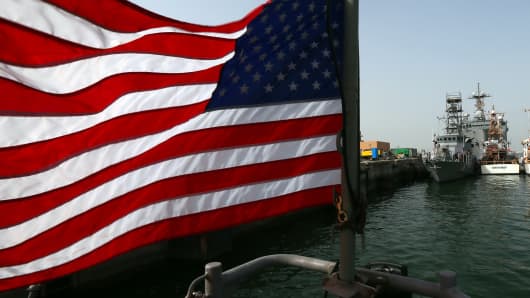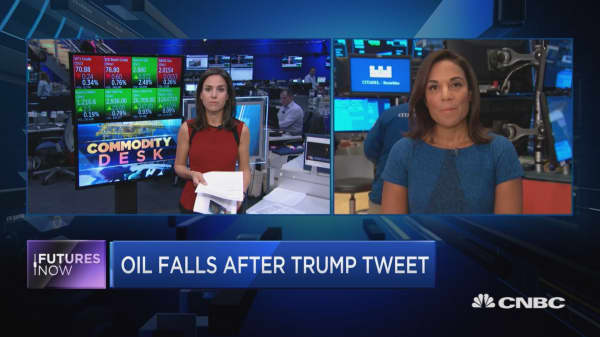Tom DiChristopher
 An American flag flies near US Navy boats docked at Bahrain's Salman port in the capital Manama, on May 12, 2013
An American flag flies near US Navy boats docked at Bahrain's Salman port in the capital Manama, on May 12, 2013
The United States military spends about $81 billion a year to protect oil supplies around the world and keep fossil fuels flowing into American gas stations, according to new analysis.
Securing America's Future Energy, a think tank that advocates for reducing U.S. dependence on oil, released the study the same day President Donald Trump claimed that some Middle Eastern countries are pushing up crude prices while benefiting from U.S. military protection.
We protect the countries of the Middle East, they would not be safe for very long without us, and yet they continue to push for higher and higher oil prices! We will remember. The OPEC monopoly must get prices down now!
The $81 billion price tag is likely "very conservative" and doesn't include the full cost of the 15-year war in Iraq, according to SAFE, whose CEO Robbie Diamond also leads the pro-electric car group the Electrification Coalition.
The estimate pencils out to 16-20 percent of the Defense Department's annual base budget, showing the nation's oil habit has a direct military cost, SAFE said. It also means the government subsidizes the cost of oil to the tune of $11.25 per barrel and the price of transportation fuels like gasoline and diesel by 28 cents a gallon.
Americans "spend somewhere around $3 per gallon, but we're really paying a lot more because of all the operations in the Middle East," said retired General Charles Wald, vice chairman and senior adviser at consulting firm Deloitte and a member of SAFE's Energy Security Leadership Council.
"If we can reduce our dependence on oil, we could reduce our presence in the Gulf and use the funds for other critical military priorities, like cybersecurity or hypersonic weapons."-General Duncan McNabb, former commander of U.S. Transportation Command
U.S. crude oil production is poised to reach 11 million barrels a day and eclipse output from top producer Russia, but the United States still imports roughly 8 million barrels a day.
On Thursday, Trump renewed his call for the 15-nation oil producer group OPEC to tamp down crude prices, which are near four-year highs. Trump suggested that OPEC members like Saudi Arabia, Iraq and Kuwait owe the United States, saying "We protect the countries of the Middle East, they would not be safe for very long without us."
To be sure, government agencies like the Environmental Protection Agency and the National Highway Traffic Safety Administration don't factor in the cost of protecting oil supplies when they set fuel policy. The agencies say the cost is actually zero because the Pentagon wouldn't save any money if it stopped defending foreign crude flows. It would simply reallocate those funds elsewhere. A 1992 Congressional Research Service assessment came to a similar conclusion, SAFE notes.
However, SAFE says this approach doesn't account for opportunity cost. In other words, the military could devote budget dollars to other priorities if it wasn't focused on protecting the parts of the world that supply the nation with oil, particularly the Persian Gulf.
"If we can reduce our dependence on oil, we could reduce our presence in the Gulf and use the funds for other critical military priorities, like cybersecurity or hypersonic weapons," said General Duncan McNabb, former commander of the U.S. Transportation Command and a member of SAFE's council.
Defending Persian Gulf oil is a "major distraction" from "existential defense issues," said John Lehman, former Secretary of the Navy under President Ronald Reagan and another member of SAFE's council.
 "Our existential threats are what we should be concentrating on. We should concentrate on East Asia and an increasingly revanchist Russia," he said.
"Our existential threats are what we should be concentrating on. We should concentrate on East Asia and an increasingly revanchist Russia," he said.
SAFE is not the first group to try to put a price on the cost of protecting oil supplies. Its study uses methodology developed by the RAND Corporation in an earlier report and draws on seven earlier studies to come up with an average. Those studies produced estimates ranging from $27 billion in 2004 to $100 billion in 2008.
Retired military commanders stressed that it is very difficult to determine the cost of a specific mission like protecting oil because defense assets serve multiple functions.
"Take the example of an aircraft carrier," said Admiral Dennis C. Blair, co-chair of the SAFE council. "It performs humanitarian operations, demonstrates a show of force, enforces no-fly zones in the Middle East, fights in wars, and lives for 50 years. How do you allocate its cost across those various missions?"
However, the exclusion of Iraq and Afghanistan war costs from most studies means the $81 billion figure likely underestimates the cost of protecting oil, members of SAFE's Energy Security Leadership Council said.
Factoring in in the cost of the Iraq War, the price of protecting oil is closer to $30 per barrel, or 70 cents a gallon, over a 20-year period, a separate analysis found. SAFE said that cost is largely separate from the ongoing cost of $81 billion a year.
"The wars in the Middle East have been related to the balance of power in that region and control over oil states," Lehman said. "You don't want to fall into the trap of the left and say that we only went into Iraq for their oil but depending how you phrase it, the costs can be attributed to the strategic dependence we have on Gulf oil."
No comments:
Post a Comment